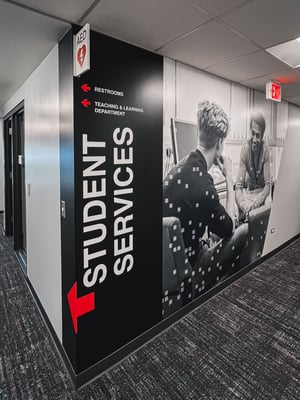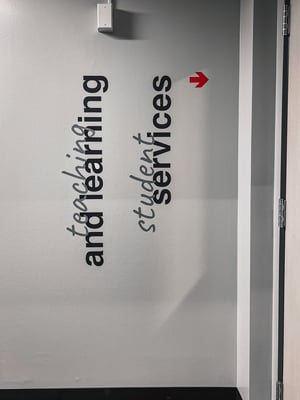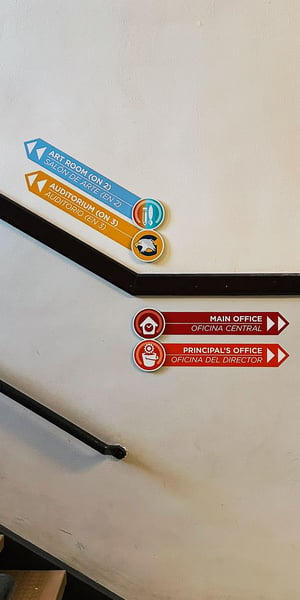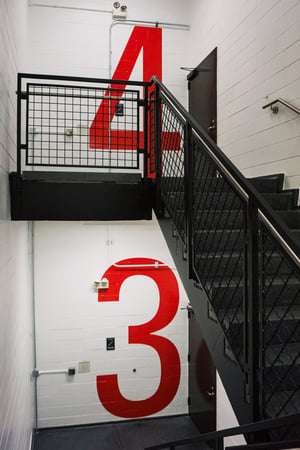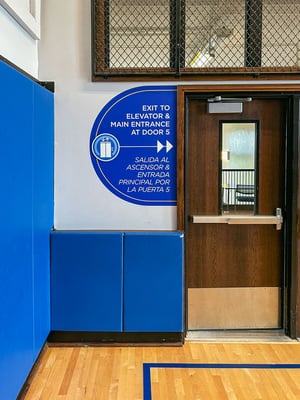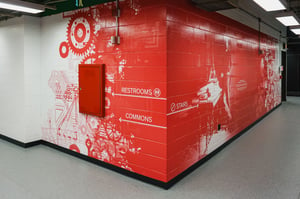Schools that invest in human-centered wayfinding strategies create supportive environments where everyone can thrive.
For schools, a well-designed wayfinding system serves as a tool for safety, inclusion, and a calmer day-to-day experience for students, staff, and visitors.
The first step to implementation is recognizing that effective wayfinding is a system, not a collection of random graphics. To design a strategy that works, schools can adapt proven approaches from healthcare and airport environments, tailoring them for the unique needs of students.

Elements of a Successful Wayfinding System
Before building the strategy, it is useful to outline the core elements that define an effective system:
Colors, symbols, and architectural cues help cluster areas into logical “districts,” making navigation intuitive.
Step 1: Secure Buy-In
Step 2: Audit Existing Signage
STEP 3: ADOPT A PHILOSOPHY
Without a guiding philosophy, signage risks becoming an afterthought. Schools must decide whether wayfinding information takes priority over competing visuals like bulletin boards.
One proven approach is to create “information zones” where signage stands apart from clutter, drawing from airport guidelines that prioritize clarity at moments of decision. Establishing a philosophy also ensures consistency when new graphics, murals, or programs are introduced.
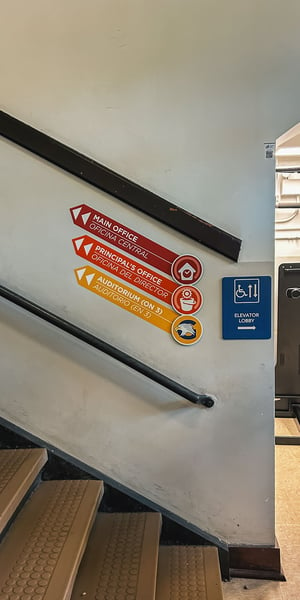
Step 4: Apply Wayfinding Logic
A clear philosophy allows schools to apply wayfinding logic in ways that match their layout and culture. David Gibson’s models from The Wayfinding Handbook provide several approaches:
- Connector Model: Use bold, continuous paths to guide movement across large campuses.
- Districts Model: Apply color-coded zones to differentiate elementary, middle, or secondary areas within a district or large facility.
- Landmarks Model: Incorporate murals, mascots, or unique graphics that serve as recognizable anchors.
- Streets Model: Design corridors that function as intuitive routes, much like a network of streets.
Choosing one or a combination of these models helps ensure signage reflects the physical environment while remaining intuitive for its users. Another important consideration is inclusivity. Multilingual signage and universally recognizable iconography can help families, staff, and students, regardless of language proficiency, navigate with confidence. For example, projects like Goethe’s bilingual system paired English and Spanish text with clear graphic icons, ensuring the space felt welcoming and accessible to all.
Step 5: Plan for Ongoing Maintenance
A wayfinding system is not a one-time project. Just like HVAC systems or technology infrastructure, signage requires upkeep. New programs, building renovations, and staff changes all demand updates. Assigning responsibility to facilities teams for regular reviews and updates prevents systems from becoming outdated or inconsistent. When maintenance is built into the strategy, signage evolves with the school rather than lagging behind it.
Building Confidence Through Strategy
When developed strategically, wayfinding transforms from decoration into a powerful tool for safety and belonging. Students arrive to class with less stress, visitors navigate confidently, and staff gain peace of mind knowing the environment supports them. By following a structured, step-by-step process, schools create systems that are clear, consistent, and sustainable. The investment is not just in signage but in the daily experience of everyone who walks the halls.
At Cushing, we believe that signage is not just about directing people from point A to point B. It is about creating environments that help people thrive.
